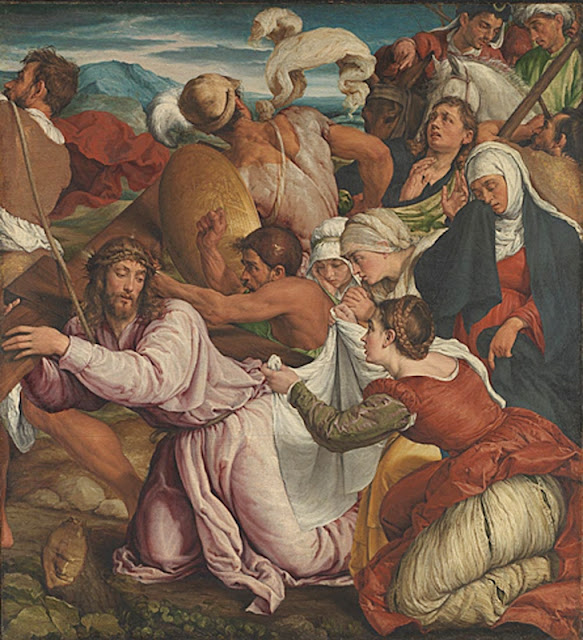With one exception the Stations of the Cross are derived
from incidents found in the Gospels or that can be inferred from the Gospel
accounts. The one exception is the Sixth
Station: Veronica Wipes the Face of
Jesus. There is no Biblical account of
this event, nor can it be inferred from a logical examination of what would
have transpired. So, where did the idea
for this Station come from?
It came from Tradition. It is often forgotten by those who assume that the New Testament contains everything there is to know about Jesus, His mission and His life. But, as St. John says “There are also many other things that Jesus did, but if these were to be described individually, I do not think the whole world would contain the books that would be written.” (John 21:25) Therefore, not everything handed down in Tradition was incorporated into the written texts that became the New Testament.
Indeed, the New Testament itself came to be as it is now through the scrutiny of the Church as the church fathers (mainly bishops) reflected on the array of written sources that began to appear within decades of Jesus’ resurrection. This period of reflection took over 100 years. Those writings that agreed with the Tradition that had been taught by the Apostles became the Canonical New Testament. Those books that disagreed with Tradition were not accepted, and there were loads of them. Thus, the New Testament is a construction of the Church, and not the other way round. 1
 |
| El Greco, The Veil of Saint Veronica Greco-Spanish, c. 1586-1595 Madrid, Museo Nacional del Prado |
 |
| Francesco Mochi, Saint Veronica Italian, c. 1629-1632 Vatican City, St. Peter's Basilica The inscription reads "Sancta Veronica Ierosolymitana" or "Saint Veronica, Woman of Jerusalem" |
According to this tradition, His face was miraculously imprinted on the
cloth and passed eventually into the possession of the Church. It is preserved at the Vatican in St. Peter’s
basilica.2
There are historical accounts
of other such miraculously imprinted images of the face of Christ, which are
called acheiropoietoe and sudaria. Among
them are the Mandylion of Edessa, the image preserved in the Sanctum Sanctorum
of the Scala Santa at the Lateran and, to a certain extent, the Shroud of Turin
(which, of course, includes much more than a face).3
The word “Veronica” is made up of two words which mean “true
image”. The real Veronica is, therefore,
not the woman, but the image on the cloth.
She has become known for the gift she was given by the suffering
Christ.
This was acknowledged by artists from the late medieval period onwards, who often created images of the sacred image, either by itself or being held by the woman named for it, Saint Veronica.
 |
| Georges Trubert, Prayer to the Holy Face From a Book of Hours French (Avignon), c. 1480-1495 New York, Pierpont Morgan Library MS M 348, fol. 1r |
But, the majority of images of Saint Veronica show the action that created the image, not just the image.
In early images the encounter takes place while Jesus is standing. Veronica may also be standing or she may be kneeling as Jesus approaches.
 | ||||
| Willem Vrelant, Saint Veronica Receives the Miraculous Image From the Hours of Catherine of Aragon Flemish, c.1460 The Hague, Koninklijk Bibliotheek MS KB 76 F 7, fol. 68v | |
Often the images show her approaching Jesus on her knees, holding out the cloth by which she intends to wipe His face or just after having received the miraculous image.
 |
| Anonymous Utrecht Painter (possibly), Christ Bearing Cross Dutch, c.1470 New York, Metropolitan Museum of Art |
 |
| Veronica Receiving the Veil Imprinted with the Face of Christ Belgian (Brussels), c.1510 New York, Metropolitan Museum of Art |
 |
| Simon Bening, Jesus Meets Veronica From the Da Costa Hours Belgian (Bruges), c. 1510-1520 New York, Pierpont Morgan Library MS M 399, fol. 82v |
In later images, both figures are on their knees. Jesus has fallen and Veronica has approached Him at this point.
 |
| Jacopo Bassano, The Way to Calvary Italian, c. 1544-1545 London, National Gallery |
 |
| Cesare Nebbia, Jesus and Veronica Italian, c. 1589-1590 Rome, Church of Santissima Trinità dei Monti |
 |
| Albrecht Duerer, Tapestry after the The Small Passion German, 1598 New York, Metropolitan Museum of Art |
 |
Peter Paul Rubens, Jesus and Veronica
Belgian, c.1634-1635
Amsterdam, Rijksmuseum |
 |
| Eustache LeSueur, Jesus and Veronica French, c. 1650-1675 Paris, Musée du Louvre |
 |
| Jacob Jordaens, Jesus and Veronica Belgian, c. 1655-1660 Amsterdam, Rijksmuseum |
 |
| Eric Gill, Jesus and Veronica English, c. 1913-1918 London, Westminster Cathedral |
She reappears in images of the Crucifixion, as we shall soon see, as a witness to His suffering and death.
© M. Duffy, 2016
__________________________________________
1 Reid, George. "Canon of the New
Testament." The Catholic Encyclopedia. Vol. 3. New
York: Robert Appleton Company, 1908. 17 Mar. 2016 ;http://www.newadvent.org/cathen/03274a.htm
2, Dégert, Antoine. "St. Veronica." The Catholic Encyclopedia. Vol. 15. New York: Robert Appleton Company, 1912.17 Mar. 2016 http://www.newadvent.org/cathen/15362a.htm
3. Acheiropoieta. See https://en.wikipedia.org/wiki/Acheiropoieta
2, Dégert, Antoine. "St. Veronica." The Catholic Encyclopedia. Vol. 15. New York: Robert Appleton Company, 1912.17 Mar. 2016 http://www.newadvent.org/cathen/15362a.htm
3. Acheiropoieta. See https://en.wikipedia.org/wiki/Acheiropoieta
Scripture texts in this
work are taken from the New American Bible, revised edition© 2010,
1991, 1986, 1970 Confraternity of Christian Doctrine, Washington, D.C. and are
used by permission of the copyright owner. All Rights Reserved. No part of the
New American Bible may be reproduced in any form without permission in writing
from the copyright owner.







No comments:
Post a Comment